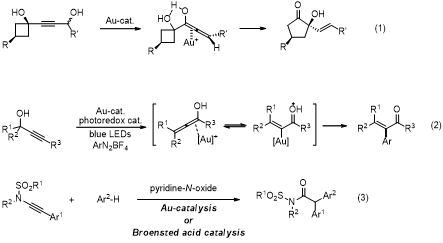11월17일(목)대학원세미나 Prof. Seunghoon Shin(Department of Chemistry, Hanyang University, South Korea)
| 초청강사 | Prof. Seunghoon Shin |
|---|---|
| 소속 | Department of Chemistry, Hanyang University, South Korea |
| 일시 | 2016년 11월 17일(목) 오후5시 |
| 장소 | 아산이학관 331 |
“Synthetic Methods Development based on
Rational Analysis of Intermediates”
Proper analysis and identification of reaction intermediates in catalysis often lead to new reaction discovery. In this presentation, we describe some of our recent investigations in the gold and Brőnsted acid catalysis. Allenols are found to be transient intermediates in the gold-catalyzed Meyer-Schuster rearrangement of propargyl alcohols en route to enones. In our tandem Meyer-Schuster rearrangement and ring expansion (eq. 1),1 the allenol intermediates play key roles in the diastereo- and enantioselective ring expansion of cyclobutanols having a butyne-1,4-diol unit into cyclopentanones. A related allenol intermediate could also be utilized in the context of cross-coupling chemistry. Compared to the dual Au-photoredox cross-coupling of C(sp3)-Au intermediates,2a the corresponding cross-coupling of C(sp2)-Au species for the formation of C(sp2)- C(sp2) coupling is more challenging, due to a facile proto-demetallation of C(sp2)-Au bond. The Au(I)-Au(III) cycle enabled under the photoredox condition is fast enough to outcompete this undesired side pathway (eq. 2).2b-c This protocol is catalytic both in gold- and photocatalyst and utilizes diazoniums for the dual role of external oxidant and coupling partner. Lastly, oxygenative cross-coupling of alkynes has received tremendous growth, as it obviates the use of diazo precursors. Yet, a concrete support for the involvement of Au-carbene species is still lacking and, especially, intermolecular coupling is very rare. Using Brőnsted acid as a catalytic promotor instead of Au-complex, this transformation occurs under exceptionally mild conditions allowing couplings of diverse nucleophiles (eq. 3). In addition, a SN2’ mechanism could be supported by the formation of scalemic products when chiral N-oxides were used.

References
1. An, J. -H.; Yun, H.; Shin, S.; Shin, S., Adv. Synth. Catal. 2014, 356, 3749.
2. (a) Sahoo, B.; Hopkinson, M. N.; Glorius, F. J. Am. Chem. Soc. 2013, 135, 5505; (b) Patil, D. V.; Yun, H.; Shin, S. Adv. Synth. Catal. 2015, 357, 2622; (c) Um, J.; Yun, H.; Shin, S. Org. Lett. 2016, 18, 484.
3. Unpublished results, Patil, D. V.; Kim, S.

